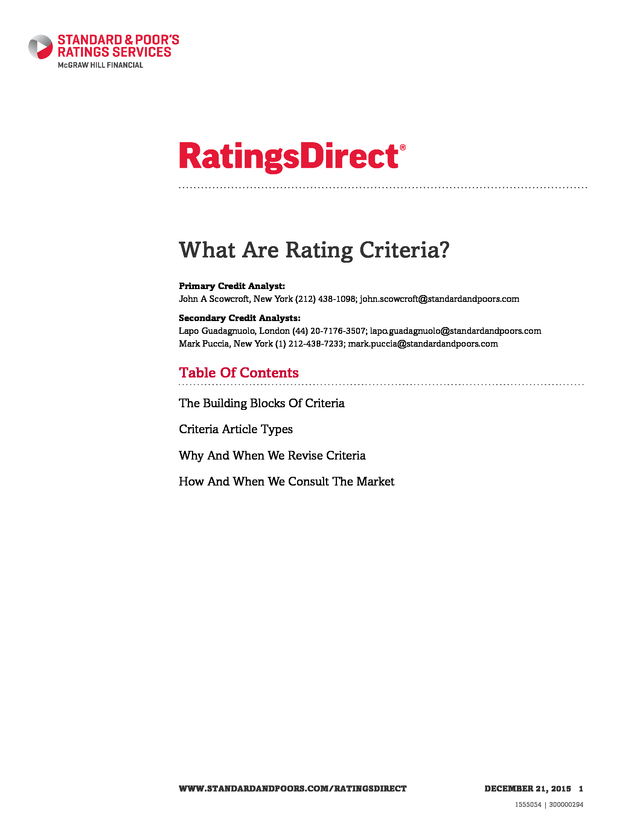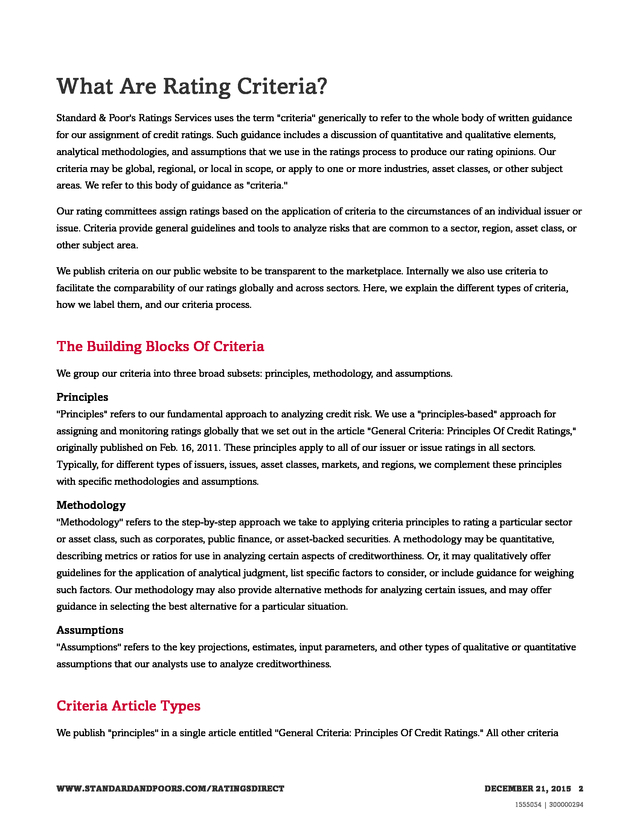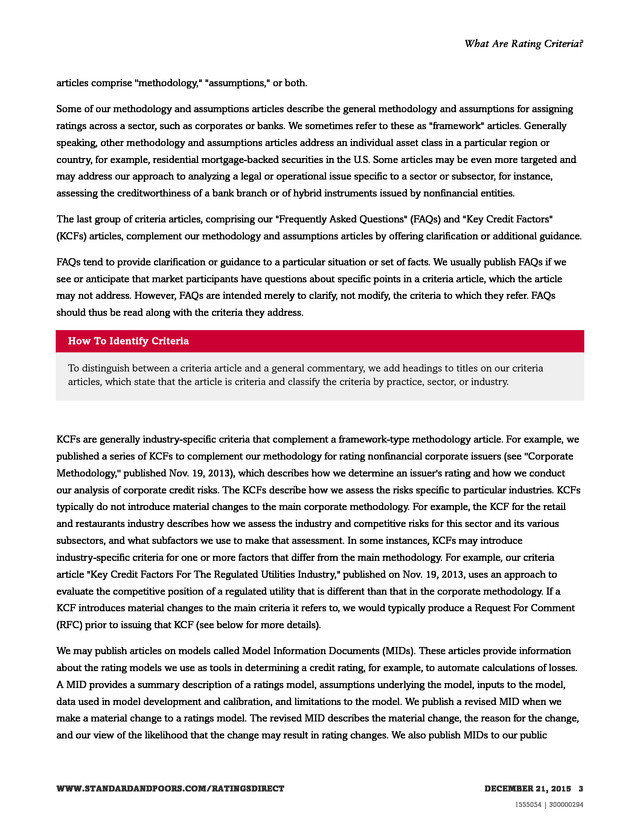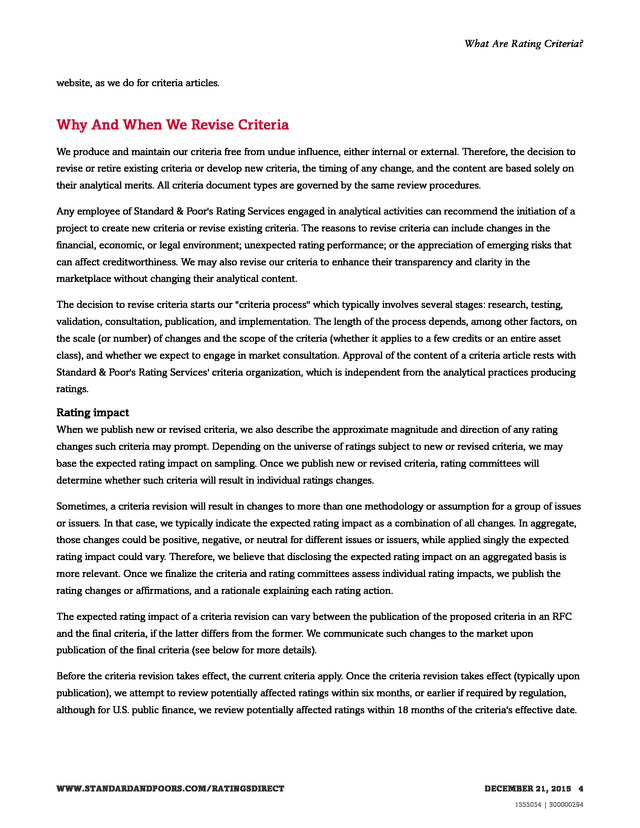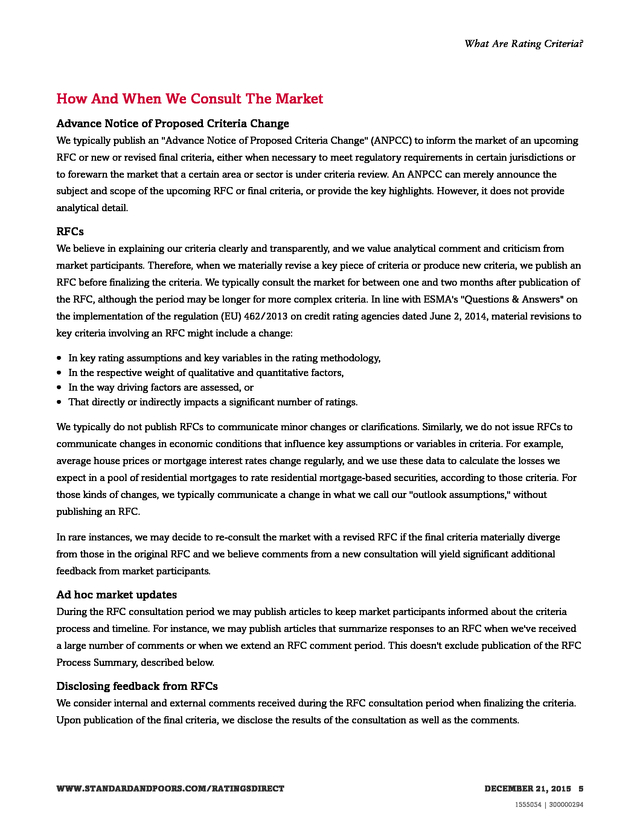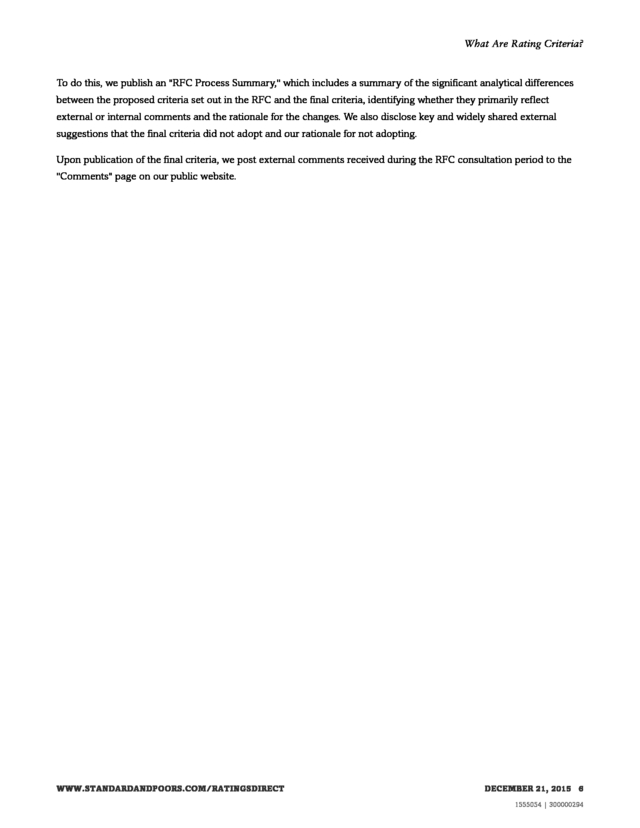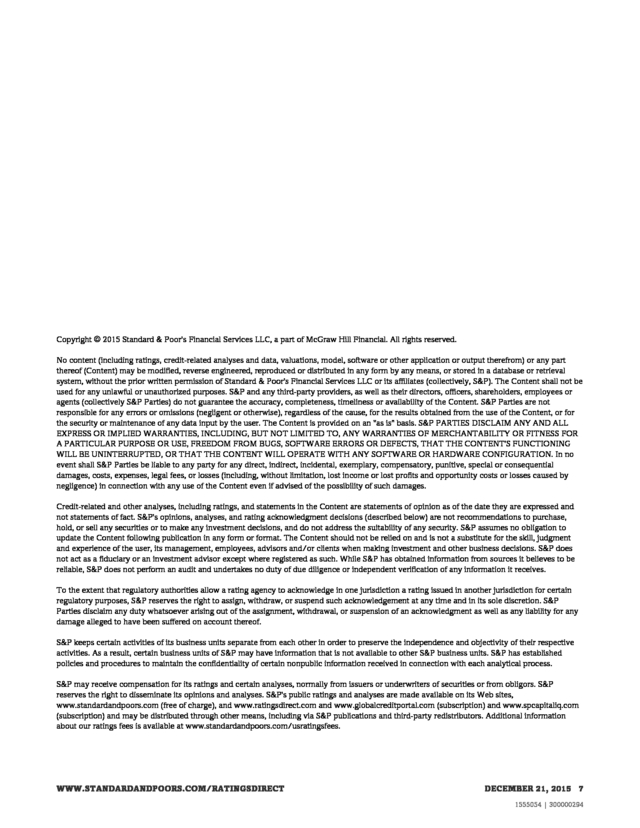Description
What Are Rating Criteria?
Primary Credit Analyst:
John A Scowcroft, New York (212) 438-1098; john.scowcroft@standardandpoors.com
Secondary Credit Analysts:
Lapo Guadagnuolo, London (44) 20-7176-3507; lapo.guadagnuolo@standardandpoors.com
Mark Puccia, New York (1) 212-438-7233; mark.puccia@standardandpoors.com
Table Of Contents
The Building Blocks Of Criteria
Criteria Article Types
Why And When We Revise Criteria
How And When We Consult The Market
WWW.STANDARDANDPOORS.COM/RATINGSDIRECT
DECEMBER 21, 2015 1
1555054 | 300000294
. What Are Rating Criteria?
Standard & Poor's Ratings Services uses the term "criteria" generically to refer to the whole body of written guidance
for our assignment of credit ratings. Such guidance includes a discussion of quantitative and qualitative elements,
analytical methodologies, and assumptions that we use in the ratings process to produce our rating opinions. Our
criteria may be global, regional, or local in scope, or apply to one or more industries, asset classes, or other subject
areas. We refer to this body of guidance as "criteria."
Our rating committees assign ratings based on the application of criteria to the circumstances of an individual issuer or
issue.
Criteria provide general guidelines and tools to analyze risks that are common to a sector, region, asset class, or other subject area. We publish criteria on our public website to be transparent to the marketplace. Internally we also use criteria to facilitate the comparability of our ratings globally and across sectors. Here, we explain the different types of criteria, how we label them, and our criteria process. The Building Blocks Of Criteria We group our criteria into three broad subsets: principles, methodology, and assumptions. Principles "Principles" refers to our fundamental approach to analyzing credit risk.
We use a "principles-based" approach for assigning and monitoring ratings globally that we set out in the article "General Criteria: Principles Of Credit Ratings," originally published on Feb. 16, 2011. These principles apply to all of our issuer or issue ratings in all sectors. Typically, for different types of issuers, issues, asset classes, markets, and regions, we complement these principles with specific methodologies and assumptions. Methodology "Methodology" refers to the step-by-step approach we take to applying criteria principles to rating a particular sector or asset class, such as corporates, public finance, or asset-backed securities.
A methodology may be quantitative, describing metrics or ratios for use in analyzing certain aspects of creditworthiness. Or, it may qualitatively offer guidelines for the application of analytical judgment, list specific factors to consider, or include guidance for weighing such factors. Our methodology may also provide alternative methods for analyzing certain issues, and may offer guidance in selecting the best alternative for a particular situation. Assumptions "Assumptions" refers to the key projections, estimates, input parameters, and other types of qualitative or quantitative assumptions that our analysts use to analyze creditworthiness. Criteria Article Types We publish "principles" in a single article entitled "General Criteria: Principles Of Credit Ratings." All other criteria WWW.STANDARDANDPOORS.COM/RATINGSDIRECT DECEMBER 21, 2015 2 1555054 | 300000294 .
What Are Rating Criteria? articles comprise "methodology," "assumptions," or both. Some of our methodology and assumptions articles describe the general methodology and assumptions for assigning ratings across a sector, such as corporates or banks. We sometimes refer to these as "framework" articles. Generally speaking, other methodology and assumptions articles address an individual asset class in a particular region or country, for example, residential mortgage-backed securities in the U.S. Some articles may be even more targeted and may address our approach to analyzing a legal or operational issue specific to a sector or subsector, for instance, assessing the creditworthiness of a bank branch or of hybrid instruments issued by nonfinancial entities. The last group of criteria articles, comprising our "Frequently Asked Questions" (FAQs) and "Key Credit Factors" (KCFs) articles, complement our methodology and assumptions articles by offering clarification or additional guidance. FAQs tend to provide clarification or guidance to a particular situation or set of facts.
We usually publish FAQs if we see or anticipate that market participants have questions about specific points in a criteria article, which the article may not address. However, FAQs are intended merely to clarify, not modify, the criteria to which they refer. FAQs should thus be read along with the criteria they address. How To Identify Criteria To distinguish between a criteria article and a general commentary, we add headings to titles on our criteria articles, which state that the article is criteria and classify the criteria by practice, sector, or industry. KCFs are generally industry-specific criteria that complement a framework-type methodology article.
For example, we published a series of KCFs to complement our methodology for rating nonfinancial corporate issuers (see "Corporate Methodology," published Nov. 19, 2013), which describes how we determine an issuer's rating and how we conduct our analysis of corporate credit risks. The KCFs describe how we assess the risks specific to particular industries.
KCFs typically do not introduce material changes to the main corporate methodology. For example, the KCF for the retail and restaurants industry describes how we assess the industry and competitive risks for this sector and its various subsectors, and what subfactors we use to make that assessment. In some instances, KCFs may introduce industry-specific criteria for one or more factors that differ from the main methodology.
For example, our criteria article "Key Credit Factors For The Regulated Utilities Industry," published on Nov. 19, 2013, uses an approach to evaluate the competitive position of a regulated utility that is different than that in the corporate methodology. If a KCF introduces material changes to the main criteria it refers to, we would typically produce a Request For Comment (RFC) prior to issuing that KCF (see below for more details). We may publish articles on models called Model Information Documents (MIDs).
These articles provide information about the rating models we use as tools in determining a credit rating, for example, to automate calculations of losses. A MID provides a summary description of a ratings model, assumptions underlying the model, inputs to the model, data used in model development and calibration, and limitations to the model. We publish a revised MID when we make a material change to a ratings model. The revised MID describes the material change, the reason for the change, and our view of the likelihood that the change may result in rating changes.
We also publish MIDs to our public WWW.STANDARDANDPOORS.COM/RATINGSDIRECT DECEMBER 21, 2015 3 1555054 | 300000294 . What Are Rating Criteria? website, as we do for criteria articles. Why And When We Revise Criteria We produce and maintain our criteria free from undue influence, either internal or external. Therefore, the decision to revise or retire existing criteria or develop new criteria, the timing of any change, and the content are based solely on their analytical merits. All criteria document types are governed by the same review procedures. Any employee of Standard & Poor's Rating Services engaged in analytical activities can recommend the initiation of a project to create new criteria or revise existing criteria. The reasons to revise criteria can include changes in the financial, economic, or legal environment; unexpected rating performance; or the appreciation of emerging risks that can affect creditworthiness.
We may also revise our criteria to enhance their transparency and clarity in the marketplace without changing their analytical content. The decision to revise criteria starts our "criteria process" which typically involves several stages: research, testing, validation, consultation, publication, and implementation. The length of the process depends, among other factors, on the scale (or number) of changes and the scope of the criteria (whether it applies to a few credits or an entire asset class), and whether we expect to engage in market consultation. Approval of the content of a criteria article rests with Standard & Poor's Rating Services' criteria organization, which is independent from the analytical practices producing ratings. Rating impact When we publish new or revised criteria, we also describe the approximate magnitude and direction of any rating changes such criteria may prompt.
Depending on the universe of ratings subject to new or revised criteria, we may base the expected rating impact on sampling. Once we publish new or revised criteria, rating committees will determine whether such criteria will result in individual ratings changes. Sometimes, a criteria revision will result in changes to more than one methodology or assumption for a group of issues or issuers. In that case, we typically indicate the expected rating impact as a combination of all changes.
In aggregate, those changes could be positive, negative, or neutral for different issues or issuers, while applied singly the expected rating impact could vary. Therefore, we believe that disclosing the expected rating impact on an aggregated basis is more relevant. Once we finalize the criteria and rating committees assess individual rating impacts, we publish the rating changes or affirmations, and a rationale explaining each rating action. The expected rating impact of a criteria revision can vary between the publication of the proposed criteria in an RFC and the final criteria, if the latter differs from the former.
We communicate such changes to the market upon publication of the final criteria (see below for more details). Before the criteria revision takes effect, the current criteria apply. Once the criteria revision takes effect (typically upon publication), we attempt to review potentially affected ratings within six months, or earlier if required by regulation, although for U.S. public finance, we review potentially affected ratings within 18 months of the criteria's effective date. WWW.STANDARDANDPOORS.COM/RATINGSDIRECT DECEMBER 21, 2015 4 1555054 | 300000294 .
What Are Rating Criteria? How And When We Consult The Market Advance Notice of Proposed Criteria Change We typically publish an "Advance Notice of Proposed Criteria Change" (ANPCC) to inform the market of an upcoming RFC or new or revised final criteria, either when necessary to meet regulatory requirements in certain jurisdictions or to forewarn the market that a certain area or sector is under criteria review. An ANPCC can merely announce the subject and scope of the upcoming RFC or final criteria, or provide the key highlights. However, it does not provide analytical detail. RFCs We believe in explaining our criteria clearly and transparently, and we value analytical comment and criticism from market participants. Therefore, when we materially revise a key piece of criteria or produce new criteria, we publish an RFC before finalizing the criteria.
We typically consult the market for between one and two months after publication of the RFC, although the period may be longer for more complex criteria. In line with ESMA's "Questions & Answers" on the implementation of the regulation (EU) 462/2013 on credit rating agencies dated June 2, 2014, material revisions to key criteria involving an RFC might include a change: • • • • In key rating assumptions and key variables in the rating methodology, In the respective weight of qualitative and quantitative factors, In the way driving factors are assessed, or That directly or indirectly impacts a significant number of ratings. We typically do not publish RFCs to communicate minor changes or clarifications. Similarly, we do not issue RFCs to communicate changes in economic conditions that influence key assumptions or variables in criteria.
For example, average house prices or mortgage interest rates change regularly, and we use these data to calculate the losses we expect in a pool of residential mortgages to rate residential mortgage-based securities, according to those criteria. For those kinds of changes, we typically communicate a change in what we call our "outlook assumptions," without publishing an RFC. In rare instances, we may decide to re-consult the market with a revised RFC if the final criteria materially diverge from those in the original RFC and we believe comments from a new consultation will yield significant additional feedback from market participants. Ad hoc market updates During the RFC consultation period we may publish articles to keep market participants informed about the criteria process and timeline. For instance, we may publish articles that summarize responses to an RFC when we've received a large number of comments or when we extend an RFC comment period.
This doesn't exclude publication of the RFC Process Summary, described below. Disclosing feedback from RFCs We consider internal and external comments received during the RFC consultation period when finalizing the criteria. Upon publication of the final criteria, we disclose the results of the consultation as well as the comments. WWW.STANDARDANDPOORS.COM/RATINGSDIRECT DECEMBER 21, 2015 5 1555054 | 300000294 . What Are Rating Criteria? To do this, we publish an "RFC Process Summary," which includes a summary of the significant analytical differences between the proposed criteria set out in the RFC and the final criteria, identifying whether they primarily reflect external or internal comments and the rationale for the changes. We also disclose key and widely shared external suggestions that the final criteria did not adopt and our rationale for not adopting. Upon publication of the final criteria, we post external comments received during the RFC consultation period to the "Comments" page on our public website. WWW.STANDARDANDPOORS.COM/RATINGSDIRECT DECEMBER 21, 2015 6 1555054 | 300000294 . Copyright © 2015 Standard & Poor's Financial Services LLC, a part of McGraw Hill Financial. All rights reserved. No content (including ratings, credit-related analyses and data, valuations, model, software or other application or output therefrom) or any part thereof (Content) may be modified, reverse engineered, reproduced or distributed in any form by any means, or stored in a database or retrieval system, without the prior written permission of Standard & Poor's Financial Services LLC or its affiliates (collectively, S&P). The Content shall not be used for any unlawful or unauthorized purposes. S&P and any third-party providers, as well as their directors, officers, shareholders, employees or agents (collectively S&P Parties) do not guarantee the accuracy, completeness, timeliness or availability of the Content.
S&P Parties are not responsible for any errors or omissions (negligent or otherwise), regardless of the cause, for the results obtained from the use of the Content, or for the security or maintenance of any data input by the user. The Content is provided on an "as is" basis. S&P PARTIES DISCLAIM ANY AND ALL EXPRESS OR IMPLIED WARRANTIES, INCLUDING, BUT NOT LIMITED TO, ANY WARRANTIES OF MERCHANTABILITY OR FITNESS FOR A PARTICULAR PURPOSE OR USE, FREEDOM FROM BUGS, SOFTWARE ERRORS OR DEFECTS, THAT THE CONTENT'S FUNCTIONING WILL BE UNINTERRUPTED, OR THAT THE CONTENT WILL OPERATE WITH ANY SOFTWARE OR HARDWARE CONFIGURATION.
In no event shall S&P Parties be liable to any party for any direct, indirect, incidental, exemplary, compensatory, punitive, special or consequential damages, costs, expenses, legal fees, or losses (including, without limitation, lost income or lost profits and opportunity costs or losses caused by negligence) in connection with any use of the Content even if advised of the possibility of such damages. Credit-related and other analyses, including ratings, and statements in the Content are statements of opinion as of the date they are expressed and not statements of fact. S&P's opinions, analyses, and rating acknowledgment decisions (described below) are not recommendations to purchase, hold, or sell any securities or to make any investment decisions, and do not address the suitability of any security. S&P assumes no obligation to update the Content following publication in any form or format.
The Content should not be relied on and is not a substitute for the skill, judgment and experience of the user, its management, employees, advisors and/or clients when making investment and other business decisions. S&P does not act as a fiduciary or an investment advisor except where registered as such. While S&P has obtained information from sources it believes to be reliable, S&P does not perform an audit and undertakes no duty of due diligence or independent verification of any information it receives. To the extent that regulatory authorities allow a rating agency to acknowledge in one jurisdiction a rating issued in another jurisdiction for certain regulatory purposes, S&P reserves the right to assign, withdraw, or suspend such acknowledgement at any time and in its sole discretion.
S&P Parties disclaim any duty whatsoever arising out of the assignment, withdrawal, or suspension of an acknowledgment as well as any liability for any damage alleged to have been suffered on account thereof. S&P keeps certain activities of its business units separate from each other in order to preserve the independence and objectivity of their respective activities. As a result, certain business units of S&P may have information that is not available to other S&P business units. S&P has established policies and procedures to maintain the confidentiality of certain nonpublic information received in connection with each analytical process. S&P may receive compensation for its ratings and certain analyses, normally from issuers or underwriters of securities or from obligors.
S&P reserves the right to disseminate its opinions and analyses. S&P's public ratings and analyses are made available on its Web sites, www.standardandpoors.com (free of charge), and www.ratingsdirect.com and www.globalcreditportal.com (subscription) and www.spcapitaliq.com (subscription) and may be distributed through other means, including via S&P publications and third-party redistributors. Additional information about our ratings fees is available at www.standardandpoors.com/usratingsfees. WWW.STANDARDANDPOORS.COM/RATINGSDIRECT DECEMBER 21, 2015 7 1555054 | 300000294 .
Criteria provide general guidelines and tools to analyze risks that are common to a sector, region, asset class, or other subject area. We publish criteria on our public website to be transparent to the marketplace. Internally we also use criteria to facilitate the comparability of our ratings globally and across sectors. Here, we explain the different types of criteria, how we label them, and our criteria process. The Building Blocks Of Criteria We group our criteria into three broad subsets: principles, methodology, and assumptions. Principles "Principles" refers to our fundamental approach to analyzing credit risk.
We use a "principles-based" approach for assigning and monitoring ratings globally that we set out in the article "General Criteria: Principles Of Credit Ratings," originally published on Feb. 16, 2011. These principles apply to all of our issuer or issue ratings in all sectors. Typically, for different types of issuers, issues, asset classes, markets, and regions, we complement these principles with specific methodologies and assumptions. Methodology "Methodology" refers to the step-by-step approach we take to applying criteria principles to rating a particular sector or asset class, such as corporates, public finance, or asset-backed securities.
A methodology may be quantitative, describing metrics or ratios for use in analyzing certain aspects of creditworthiness. Or, it may qualitatively offer guidelines for the application of analytical judgment, list specific factors to consider, or include guidance for weighing such factors. Our methodology may also provide alternative methods for analyzing certain issues, and may offer guidance in selecting the best alternative for a particular situation. Assumptions "Assumptions" refers to the key projections, estimates, input parameters, and other types of qualitative or quantitative assumptions that our analysts use to analyze creditworthiness. Criteria Article Types We publish "principles" in a single article entitled "General Criteria: Principles Of Credit Ratings." All other criteria WWW.STANDARDANDPOORS.COM/RATINGSDIRECT DECEMBER 21, 2015 2 1555054 | 300000294 .
What Are Rating Criteria? articles comprise "methodology," "assumptions," or both. Some of our methodology and assumptions articles describe the general methodology and assumptions for assigning ratings across a sector, such as corporates or banks. We sometimes refer to these as "framework" articles. Generally speaking, other methodology and assumptions articles address an individual asset class in a particular region or country, for example, residential mortgage-backed securities in the U.S. Some articles may be even more targeted and may address our approach to analyzing a legal or operational issue specific to a sector or subsector, for instance, assessing the creditworthiness of a bank branch or of hybrid instruments issued by nonfinancial entities. The last group of criteria articles, comprising our "Frequently Asked Questions" (FAQs) and "Key Credit Factors" (KCFs) articles, complement our methodology and assumptions articles by offering clarification or additional guidance. FAQs tend to provide clarification or guidance to a particular situation or set of facts.
We usually publish FAQs if we see or anticipate that market participants have questions about specific points in a criteria article, which the article may not address. However, FAQs are intended merely to clarify, not modify, the criteria to which they refer. FAQs should thus be read along with the criteria they address. How To Identify Criteria To distinguish between a criteria article and a general commentary, we add headings to titles on our criteria articles, which state that the article is criteria and classify the criteria by practice, sector, or industry. KCFs are generally industry-specific criteria that complement a framework-type methodology article.
For example, we published a series of KCFs to complement our methodology for rating nonfinancial corporate issuers (see "Corporate Methodology," published Nov. 19, 2013), which describes how we determine an issuer's rating and how we conduct our analysis of corporate credit risks. The KCFs describe how we assess the risks specific to particular industries.
KCFs typically do not introduce material changes to the main corporate methodology. For example, the KCF for the retail and restaurants industry describes how we assess the industry and competitive risks for this sector and its various subsectors, and what subfactors we use to make that assessment. In some instances, KCFs may introduce industry-specific criteria for one or more factors that differ from the main methodology.
For example, our criteria article "Key Credit Factors For The Regulated Utilities Industry," published on Nov. 19, 2013, uses an approach to evaluate the competitive position of a regulated utility that is different than that in the corporate methodology. If a KCF introduces material changes to the main criteria it refers to, we would typically produce a Request For Comment (RFC) prior to issuing that KCF (see below for more details). We may publish articles on models called Model Information Documents (MIDs).
These articles provide information about the rating models we use as tools in determining a credit rating, for example, to automate calculations of losses. A MID provides a summary description of a ratings model, assumptions underlying the model, inputs to the model, data used in model development and calibration, and limitations to the model. We publish a revised MID when we make a material change to a ratings model. The revised MID describes the material change, the reason for the change, and our view of the likelihood that the change may result in rating changes.
We also publish MIDs to our public WWW.STANDARDANDPOORS.COM/RATINGSDIRECT DECEMBER 21, 2015 3 1555054 | 300000294 . What Are Rating Criteria? website, as we do for criteria articles. Why And When We Revise Criteria We produce and maintain our criteria free from undue influence, either internal or external. Therefore, the decision to revise or retire existing criteria or develop new criteria, the timing of any change, and the content are based solely on their analytical merits. All criteria document types are governed by the same review procedures. Any employee of Standard & Poor's Rating Services engaged in analytical activities can recommend the initiation of a project to create new criteria or revise existing criteria. The reasons to revise criteria can include changes in the financial, economic, or legal environment; unexpected rating performance; or the appreciation of emerging risks that can affect creditworthiness.
We may also revise our criteria to enhance their transparency and clarity in the marketplace without changing their analytical content. The decision to revise criteria starts our "criteria process" which typically involves several stages: research, testing, validation, consultation, publication, and implementation. The length of the process depends, among other factors, on the scale (or number) of changes and the scope of the criteria (whether it applies to a few credits or an entire asset class), and whether we expect to engage in market consultation. Approval of the content of a criteria article rests with Standard & Poor's Rating Services' criteria organization, which is independent from the analytical practices producing ratings. Rating impact When we publish new or revised criteria, we also describe the approximate magnitude and direction of any rating changes such criteria may prompt.
Depending on the universe of ratings subject to new or revised criteria, we may base the expected rating impact on sampling. Once we publish new or revised criteria, rating committees will determine whether such criteria will result in individual ratings changes. Sometimes, a criteria revision will result in changes to more than one methodology or assumption for a group of issues or issuers. In that case, we typically indicate the expected rating impact as a combination of all changes.
In aggregate, those changes could be positive, negative, or neutral for different issues or issuers, while applied singly the expected rating impact could vary. Therefore, we believe that disclosing the expected rating impact on an aggregated basis is more relevant. Once we finalize the criteria and rating committees assess individual rating impacts, we publish the rating changes or affirmations, and a rationale explaining each rating action. The expected rating impact of a criteria revision can vary between the publication of the proposed criteria in an RFC and the final criteria, if the latter differs from the former.
We communicate such changes to the market upon publication of the final criteria (see below for more details). Before the criteria revision takes effect, the current criteria apply. Once the criteria revision takes effect (typically upon publication), we attempt to review potentially affected ratings within six months, or earlier if required by regulation, although for U.S. public finance, we review potentially affected ratings within 18 months of the criteria's effective date. WWW.STANDARDANDPOORS.COM/RATINGSDIRECT DECEMBER 21, 2015 4 1555054 | 300000294 .
What Are Rating Criteria? How And When We Consult The Market Advance Notice of Proposed Criteria Change We typically publish an "Advance Notice of Proposed Criteria Change" (ANPCC) to inform the market of an upcoming RFC or new or revised final criteria, either when necessary to meet regulatory requirements in certain jurisdictions or to forewarn the market that a certain area or sector is under criteria review. An ANPCC can merely announce the subject and scope of the upcoming RFC or final criteria, or provide the key highlights. However, it does not provide analytical detail. RFCs We believe in explaining our criteria clearly and transparently, and we value analytical comment and criticism from market participants. Therefore, when we materially revise a key piece of criteria or produce new criteria, we publish an RFC before finalizing the criteria.
We typically consult the market for between one and two months after publication of the RFC, although the period may be longer for more complex criteria. In line with ESMA's "Questions & Answers" on the implementation of the regulation (EU) 462/2013 on credit rating agencies dated June 2, 2014, material revisions to key criteria involving an RFC might include a change: • • • • In key rating assumptions and key variables in the rating methodology, In the respective weight of qualitative and quantitative factors, In the way driving factors are assessed, or That directly or indirectly impacts a significant number of ratings. We typically do not publish RFCs to communicate minor changes or clarifications. Similarly, we do not issue RFCs to communicate changes in economic conditions that influence key assumptions or variables in criteria.
For example, average house prices or mortgage interest rates change regularly, and we use these data to calculate the losses we expect in a pool of residential mortgages to rate residential mortgage-based securities, according to those criteria. For those kinds of changes, we typically communicate a change in what we call our "outlook assumptions," without publishing an RFC. In rare instances, we may decide to re-consult the market with a revised RFC if the final criteria materially diverge from those in the original RFC and we believe comments from a new consultation will yield significant additional feedback from market participants. Ad hoc market updates During the RFC consultation period we may publish articles to keep market participants informed about the criteria process and timeline. For instance, we may publish articles that summarize responses to an RFC when we've received a large number of comments or when we extend an RFC comment period.
This doesn't exclude publication of the RFC Process Summary, described below. Disclosing feedback from RFCs We consider internal and external comments received during the RFC consultation period when finalizing the criteria. Upon publication of the final criteria, we disclose the results of the consultation as well as the comments. WWW.STANDARDANDPOORS.COM/RATINGSDIRECT DECEMBER 21, 2015 5 1555054 | 300000294 . What Are Rating Criteria? To do this, we publish an "RFC Process Summary," which includes a summary of the significant analytical differences between the proposed criteria set out in the RFC and the final criteria, identifying whether they primarily reflect external or internal comments and the rationale for the changes. We also disclose key and widely shared external suggestions that the final criteria did not adopt and our rationale for not adopting. Upon publication of the final criteria, we post external comments received during the RFC consultation period to the "Comments" page on our public website. WWW.STANDARDANDPOORS.COM/RATINGSDIRECT DECEMBER 21, 2015 6 1555054 | 300000294 . Copyright © 2015 Standard & Poor's Financial Services LLC, a part of McGraw Hill Financial. All rights reserved. No content (including ratings, credit-related analyses and data, valuations, model, software or other application or output therefrom) or any part thereof (Content) may be modified, reverse engineered, reproduced or distributed in any form by any means, or stored in a database or retrieval system, without the prior written permission of Standard & Poor's Financial Services LLC or its affiliates (collectively, S&P). The Content shall not be used for any unlawful or unauthorized purposes. S&P and any third-party providers, as well as their directors, officers, shareholders, employees or agents (collectively S&P Parties) do not guarantee the accuracy, completeness, timeliness or availability of the Content.
S&P Parties are not responsible for any errors or omissions (negligent or otherwise), regardless of the cause, for the results obtained from the use of the Content, or for the security or maintenance of any data input by the user. The Content is provided on an "as is" basis. S&P PARTIES DISCLAIM ANY AND ALL EXPRESS OR IMPLIED WARRANTIES, INCLUDING, BUT NOT LIMITED TO, ANY WARRANTIES OF MERCHANTABILITY OR FITNESS FOR A PARTICULAR PURPOSE OR USE, FREEDOM FROM BUGS, SOFTWARE ERRORS OR DEFECTS, THAT THE CONTENT'S FUNCTIONING WILL BE UNINTERRUPTED, OR THAT THE CONTENT WILL OPERATE WITH ANY SOFTWARE OR HARDWARE CONFIGURATION.
In no event shall S&P Parties be liable to any party for any direct, indirect, incidental, exemplary, compensatory, punitive, special or consequential damages, costs, expenses, legal fees, or losses (including, without limitation, lost income or lost profits and opportunity costs or losses caused by negligence) in connection with any use of the Content even if advised of the possibility of such damages. Credit-related and other analyses, including ratings, and statements in the Content are statements of opinion as of the date they are expressed and not statements of fact. S&P's opinions, analyses, and rating acknowledgment decisions (described below) are not recommendations to purchase, hold, or sell any securities or to make any investment decisions, and do not address the suitability of any security. S&P assumes no obligation to update the Content following publication in any form or format.
The Content should not be relied on and is not a substitute for the skill, judgment and experience of the user, its management, employees, advisors and/or clients when making investment and other business decisions. S&P does not act as a fiduciary or an investment advisor except where registered as such. While S&P has obtained information from sources it believes to be reliable, S&P does not perform an audit and undertakes no duty of due diligence or independent verification of any information it receives. To the extent that regulatory authorities allow a rating agency to acknowledge in one jurisdiction a rating issued in another jurisdiction for certain regulatory purposes, S&P reserves the right to assign, withdraw, or suspend such acknowledgement at any time and in its sole discretion.
S&P Parties disclaim any duty whatsoever arising out of the assignment, withdrawal, or suspension of an acknowledgment as well as any liability for any damage alleged to have been suffered on account thereof. S&P keeps certain activities of its business units separate from each other in order to preserve the independence and objectivity of their respective activities. As a result, certain business units of S&P may have information that is not available to other S&P business units. S&P has established policies and procedures to maintain the confidentiality of certain nonpublic information received in connection with each analytical process. S&P may receive compensation for its ratings and certain analyses, normally from issuers or underwriters of securities or from obligors.
S&P reserves the right to disseminate its opinions and analyses. S&P's public ratings and analyses are made available on its Web sites, www.standardandpoors.com (free of charge), and www.ratingsdirect.com and www.globalcreditportal.com (subscription) and www.spcapitaliq.com (subscription) and may be distributed through other means, including via S&P publications and third-party redistributors. Additional information about our ratings fees is available at www.standardandpoors.com/usratingsfees. WWW.STANDARDANDPOORS.COM/RATINGSDIRECT DECEMBER 21, 2015 7 1555054 | 300000294 .



